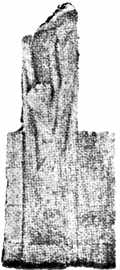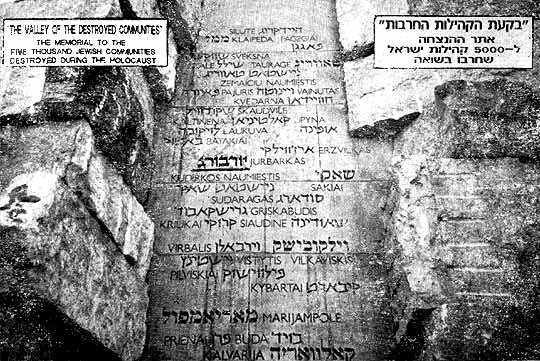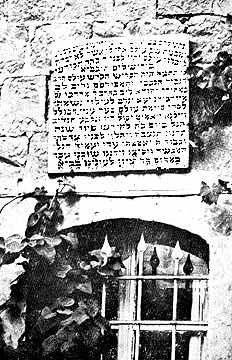
Statue of Ze'ev Ben Tzvi
|
(Psalms 78 -6)
Dark nights in the forest
In the dark nights in the Shvantshani forest
Children stood in front of open pits-
Crying and wailing .. .
The cruel people hit and kill
And spill their blood . . .
One after another they throw them into the pits -
Jewish children . . .
A boy, another boy, and a little girl too
They die there, screaming -
MOTHER! . . MOTHER!. . .
And the mad murderers trample on their bodies
And pile them into a heap
Growing higher and higher
And the night is dark, a cold wind is blowing
A wind of terror . . .
In the Shvantshani Forest
Oh, the Shvantshani forest,
The victims' burial place
You swallowed them all
For always and ever
There, over the pits of death
An evil spirit roams
Over the bones of our loved ones
Lying in your earth
Over the top of the trees
The terror hovers
And the sounds of a mother embrace
The wounds of its victim
WHY, MOTHER, WHY
Why, mother dear,
I ask - why
Did little Rivkale
Fall asleep forever?
Why, why, why,
Are my brothers and sisters no longer -
What crime did they commit
That evil men devoured them?
Mother, Mother, why
Don't you answer me?
Shall we ever see
The sun shine again?

Statue of Ze'ev Ben Tzvi

THE VALLEY OF DESTROYED COMMUNITIES. Is located in Jerusalem at Yad Vashem. There are names 5000 communities, whose names are written in the Jerusalem stone.THE VALLEY OF DESTROYED COMMUNITIES. It was created for the purpose of commerating our parents, brothers and sisters, commerate the Jewish communities and that includes the names of our loved ones. From the Jewish people in Israel and in the Diaspora.
"Those who see the places of living that look like dusty holes will be most astonished . . . if kind-hearted souls want to help these poor people, then the first thing they need is a clean and healthy place of living."
Their economic conditions were also poor. The majority lived on "distribution" funds, collected by emissaries in the Jewish communities in Europe. Few were small tradesmen, had a grocery store or workshop. There was endless poverty and suffering. The majority of the Jewish population were Sephardic Jews, who had lived here for many generations, and a few were Ashkenaz Jews. All of them lived in terrible circumstances and unbearable poverty. Nevertheless, aliyah to Israel did not cease - from Kurdistan, North Africa, Eastern Europe. The holiness of Jerusalem attracted them in spite of the economic difficulties and living problems. In those years the philanthropist and public personality Sir Moshe Montefiori (1784-1885), helped the Jews in Eretz Israel. He visited Israel seven times, together with his wife Judith. Montefiori was well aware of the Jews' difficult living conditions and decided to do something about it. Montefiori thought of a daring idea - to move the Jews out of the suffocating quarter to beyond the walls of Jerusalem. The financial means to realize this idea were also found. At that time, 5614 (1854), a rich and generous Sephardic Jew called Turo died in the town of Orleans in the U.S.A. In his will Turo left a sum of money - about $ 60,000- to the poor people of Jerusalem. This donation was handed over to Montefiori by the administrator, and he decided to use it to realize his plan, i.e. to purchase a piece of land and set up a neighborhood for the Jews outside the walls of the old city.
That is what happened. In 5620 (1860) the first building for the Jews was completed, outside the walls of Jerusalem, on a rocky hill, opposite Mt. Zion. The quarter was called Mishkenot She'ananim. Half of the settlers were Sephardic and the other half Ashkenaz.
In 5628 (1868) a new neighborhood was established - the second one - of Jews of Moroccan origin, (presently: to the west of the "King David" hotel), and this quarter was called Mahaneh Israel or in the popular tongue: the neighborhood of the western people.
A year later Ashkenaz Jews bought an area of land to the west of Mahaneh Israel and here on the second of Ayar 5629 (1869) the third quarter was established, called Nahlat Shiva, named after its seven founders.
Further on I plan to speak about the Nahlat Shiva quarter and the interest it holds for us, former residents of Yurburg.
Rabbi Yoel-Moshe Salomon, one of the quarter's founders and one of the editors ofthe "Torah meZion" newspaper says the following in his memoirs:
On Lag ba Omer 5626 (1866) Rabbi Moshe-Yoel Salomon went for a walk on the road leading to Yaffo. On the same road (opposite the Russian compound and the police - at present) he came upon a field where lentils and beans were growing and peasants were working. Salomon struck up a conversation with them regarding the purchase of the land for building there. The peasants agreed to sell the land and asked for half a cent per ell. Rabbi Yoel Salomon informed his friend Rabbi Yosef Rivlin, the man whose dream it was to further Jewish settlement, about his offer to buy the area, and he encouraged him to do so.
Next day Rabbi Moshe Yoel Salomon found another five partners for this idea and they were:
Yoshua Yelin, the founder of the well-known Yelin family in Jerusalem;
Michael Hacohen, a partner in the newspaper business;
Benjamin (Beinish) Salant, the son of Rabbi Shmuel Salant, the chief Ashkenaz Rabbi in Jerusalem;
Haim Halevy (Kovner), the first emissary who went abroad to collect donations for building the "Hahorva" synagogue;
Arie Leib Horowitz in whose wife's name - she was a Turkish national - the quarter's land was registered and to whom the property certificate was registered. That is why at the time the jesters of the "Nahalat Shiva" founder's generation would say: " seven people held on to one woman. . ."
After a while, Rabbi Yosef Rivlin, called "Yasha der Shtettel Macher (Yasha the town maker)" laid the foundation for a number of neighborhoods in Jerusalem and was the first man to build his home at Nahlat Shiva and also the first to settle there. When all the houses of the quarter had been built, all seven families settled there.
Soon Nahlat Shiva became a very lively neighborhood. Apartments were rented there, shops and even coffee shops. . .slowly it became the nucleus of the new town outside the walls of Jerusalem. Two streets in the neighborhood are named after the two founders today - Yoel Moshe Salomon Street and Yosef Rivlin Street, both of them old-timers of Lithuanian origin, the grandsons of the pupils of the Gerer Rebbe..
This is where it becomes interesting to us, from Yurburg, to tell the story of the Nahlat Shiva quarter:
One day, hundred years after Nahlat Shiva was founded, the writer of this article went for a walk along the alleys of the aging neighborhood in the center of Jerusalem, which, by the way, is being renovated these days. All of a sudden I saw an old marble plaque attached to the front of a two-storey stone house, at the corner of 18 Salomon street. When I looked closely at the letters inscribed on the marble I noticed the word "Yurburg" .. . yes, Yurburg, who would believe it, Yurburg at Nahlat Shiva. Here I stood wondering in front of the plaque on which Yurburg was clearly inscribed. It was hard to read the entire text of the plaque, for the letters had become unclear. The text was a rabbinical text.

The Yurburg House in Jerusalem
Plaque that is on the Entrance of the House
-What to do? I decided to contact a few of my friends from Lithuania and Yurburg. I also shared the secret with the Chairman of the Former Residents of Yurburg Association, Shimon Simonov. A photograph was taken of the plaque, and once the text was deciphered we indeed found a connection between this house and its owners, formerly of Yurburg. We were curious to know who owned the house now and who was living there, and we approached the entrance floor of the house and knocked on the door. An old woman opened the door. We saw a few rooms in the apartment, most of them in disarray. We asked her what she knew about the house of Yurburg. The woman was surprised and alarmed. "Yurburg, Yurburg . . . she whispered. I have never heard that name, she said. She had already lived in this house for many years, and didn't care what was written on the plaque. She said the house belonged to the municipality and she was merely a tenant, paying rent. She now planned to leave town with her family. If we were interested in the apartment she was ready to let it to us for "key money", as was the custom. When we heard this we immediately got an idea into our head .. if we would get this house we could turn it into a "Yurburg house". Former residents of Yurburg would come to it from all over the country and remember the past, relax etc. etc. - all sorts of ideas and thoughts ran through our head.. . . We asked the house owner what the sum of "key money" would be and she mentioned an astronomical amount. We were disappointed. The association would never be able to raise such a sum. We no longer wished to climb to the second floor. We turned to the Jerusalem municipality in order to check her connection with this house to which she had a right (she owned ?), but the clerks at the municipality only knew that the house had been registered as municipal property for years, perhaps even from as far back as the Turkish period and perhaps from the British mandate period. They collected rent and that was all.
We told them of our connection to this house and how important it was to us as historical property. They replied: "try to reach a compromise with the tenants. . ."
We left the house very sad. We had to let go of a dream . . .but we were very disturbed about the history of the house and its initial owners, as written on the plaque. We contacted our old geographist friends, researchers of Jerusalem, and they were the late Zeev Vilnai and David Benvenisti. We showed them photographs of the plaque testifying to the connection with former residents of Yurburg and the house, those who had built it, its owners and first inhabitants. Unfortunately the researchers found nothing. The house remained a mystery even when we deciphered the handwritten text of the historical marble plaque. Here we would like to take the opportunity to show you the photograph of the marble plaque and its text:
|
In this home and these walls I have given them a worthy
memorial for sons and daughters, an eternal name that shall never be erased, God shall remember them on the Holy Mountain in Jerusalem - may it be built soon in our days - Amen. For these premises were dedicated by the honorable, illustrious and gracious Rabbi - our Rabbi Yehuda Leib, the son of Rabbi Mordehai - blessed be his memory - from Yurburg - May God look after them. He donated it for the glorification of his soul It shall forever be to the benefit of the poor from the Kolel -Vilna and Zamot. This philanthropist passed away on 28 Sivan 1894 May his soul live on forever - his gracious deeds shall be remembered And God will keep him until the dead rise again on the Mountain of Zion Soon, in our days, Amen. |
To this very day our heart pounds when we pass this house on 18 Salomon street. Salomon street flourishes at present. It was totally renovated and has turned into a promenade linked to the Ben Yehuda street promenade. The entire neighborhood of Nahlat Shiva has turned into a kind of historical museum, in the center of Jerusalem. We hope that those who develop the quarter will also discover the historical plaque and give it the prominence it deserves.
As former residents of Yurburg we are proud of this Jew, Torah scholar, who left Yurburg and emigrated to Israel a century ago, guided by the love for Eretz Jisrael. The text of the marble plaque shows that when the owner died the house became public property, for Lithuanians who would come to live in Jerusalem. Former residents of Yurburg who come to Jerusalem should go to this corner house and look at the plaque of the old stone house.
Once upon a time there was a town called Yurburg, a glorious Jewish settlement in the land of Lithuania, now it exists no longer. Any memory of Yurburg is dear to those who come from this town, and the house in Nahlat Shiva is one of the dearest memories for those who have come from Yurburg to the State of Israel.
|
JewishGen, Inc. makes no representations regarding the accuracy of
the translation. The reader may wish to refer to the original material
for verification.
JewishGen is not responsible for inaccuracies or omissions in the original work and cannot rewrite or edit the text to correct inaccuracies and/or omissions.
Our mission is to produce a translation of the original work and we cannot verify the accuracy of statements or alter facts cited.
 Jurbarkas, Lithuania
Jurbarkas, Lithuania
 Yizkor Book Project
Yizkor Book Project
 JewishGen Home Page
JewishGen Home Page
Copyright © 1999-2024 by JewishGen, Inc.
Updated 11 Sep 2005 by LA